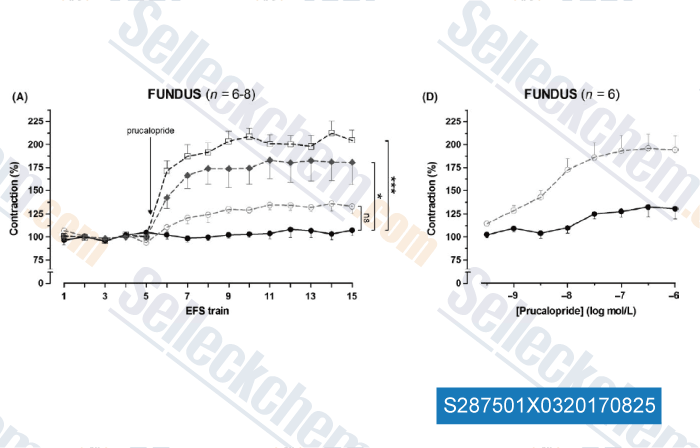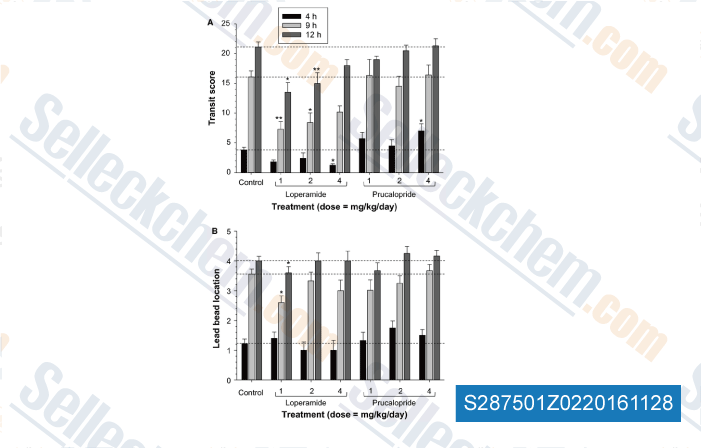|
Toll Free: (877) 796-6397 -- USA and Canada only -- |
Fax: +1-832-582-8590 Orders: +1-832-582-8158 |
Tech Support: +1-832-582-8158 Ext:3 Please provide your Order Number in the email. |
Technical Data
| Formula | C18H26ClN3O3 |
|||
| Molecular Weight | 367.87 | CAS No. | 179474-81-8 | |
| Solubility (25°C)* | In vitro | DMSO | 74 mg/mL (201.15 mM) | |
| Ethanol | 74 mg/mL (201.15 mM) | |||
| Water | Insoluble | |||
|
* <1 mg/ml means slightly soluble or insoluble. * Please note that Selleck tests the solubility of all compounds in-house, and the actual solubility may differ slightly from published values. This is normal and is due to slight batch-to-batch variations. * Room temperature shipping (Stability testing shows this product can be shipped without any cooling measures.) |
||||
Preparing Stock Solutions
Biological Activity
| Description | Prucalopride (R-93877) is a selective, high affinity 5-HT receptor agonist for 5-HT4A and 5-HT4B receptor with Ki of 2.5 nM and 8 nM, respectively, exhibits >290-fold selectivity against other 5-HT receptor subtypes. | ||||
|---|---|---|---|---|---|
| Targets |
|
||||
| In vitro | Prucalopride induces contractions in a concentration-dependent manner with pEC50 of 7.5. Prucalopride (1 mM) significantly amplifies the rebound contraction of the guinea-pig proximal colon after electrical field stimulation. Prucalopride induces relaxation of the rat oesophagus preparation of rat oesophagus tunica muscularis mucosae with pEC50 of 7.8, yielding a monophasic concentration–response curve. [1] | ||||
| In vivo | Complete bowel movements per week is 30.9% of those receiving 2 mg of Prucalopride and 28.4% of those receiving 4 mg of Prucalopride, as compared with 12.0% in the placebo group. 47.3% of patients receiving 2 mg of Prucalopride and 46.6% of those receiving 4 mg of Prucalopride has an increase in the number of spontaneous, complete bowel movements of one or more per week, on average, as compared with 25.8% in the placebo group. Prucalopride (2 mg or 4 mg) significantly improves all other secondary efficacy end points, including patients' satisfaction with their bowel function and treatment and their perception of the severity of their constipation symptoms. [2] Prucalopride (4 mg daily) accelerates overall gastric emptying and small bowel transit in patients with constipation without a rectal evacuation disorder. Prucalopride (4 mg daily) tends to accelerate overall colonic transit with significantly faster overall colonic transit and ascending colon emptying. [3] Higher proportions of patients on prucalopride 2 mg (19.5%), 4 mg (23.6%) has three or more spontaneous complete bowel movements(SCBM)/week compared with placebo (9.6%). Prucalopride also significantly improves secondary efficacy and quality of life endpoints, including the proportion of patients with an increase of one or more SCBM/week, evacuation completeness, perceived disease severity and treatment effectiveness and quality of life. [4] Prucalopride alters colonic contractile motility patterns in a dose-dependent fashion by stimulating high-amplitude clustered contractions in the proximal colon and by inhibiting contractile activity in the distal colon of fasted dogs. Prucalopride also causes a dose-dependent decrease in the time to the first giant migrating contraction (GMC); at higher doses of prucalopride, the first GMC generally occurres within the first half-hour after treatment. [5] |
Protocol (from reference)
References
Customer Product Validation

-
, , Neurogastroenterol Motil, 2017, doi: 10.1111/nmo.13064

-
Data from [Data independently produced by , , Neurogastroenterol Motil, 2016, 28(8):1241-51.]
Selleck's Prucalopride has been cited by 5 publications
| Preoperative administration of the 5-HT4 receptor agonist prucalopride reduces intestinal inflammation and shortens postoperative ileus via cholinergic enteric neurons. [ Gut, 2019, 68(8):1406-1416] | PubMed: 30472681 |
| Modulation of Cytokine-Induced Astrocytic Endothelin-1 Production as a Possible New Approach to the Treatment of Multiple Sclerosis [ Front Pharmacol, 2019, 10:1491] | PubMed: 31969819 |
| Gastric Emptying and Gastrointestinal Transit Compared among Native and Hydrolyzed Whey and Casein Milk Proteins in an Aged Rat Model. [ Nutrients, 2017, 9(12)] | PubMed: 29236034 |
| 5-HT4 receptors facilitate cholinergic neurotransmission throughout the murine gastrointestinal tract. [Pauwelyn V, et al. Neurogastroenterol Motil, 2017, 10.1111/nmo.13064] | PubMed: 28332745 |
| Tracking gastrointestinal transit of solids in aged rats as pharmacological models of chronic dysmotility. [Dalziel JE, et al. Neurogastroenterol Motil, 2016, 28(8):1241-51] | PubMed: 27028044 |
RETURN POLICY
Selleck Chemical’s Unconditional Return Policy ensures a smooth online shopping experience for our customers. If you are in any way unsatisfied with your purchase, you may return any item(s) within 7 days of receiving it. In the event of product quality issues, either protocol related or product related problems, you may return any item(s) within 365 days from the original purchase date. Please follow the instructions below when returning products.
SHIPPING AND STORAGE
Selleck products are transported at room temperature. If you receive the product at room temperature, please rest assured, the Selleck Quality Inspection Department has conducted experiments to verify that the normal temperature placement of one month will not affect the biological activity of powder products. After collecting, please store the product according to the requirements described in the datasheet. Most Selleck products are stable under the recommended conditions.
NOT FOR HUMAN, VETERINARY DIAGNOSTIC OR THERAPEUTIC USE.
